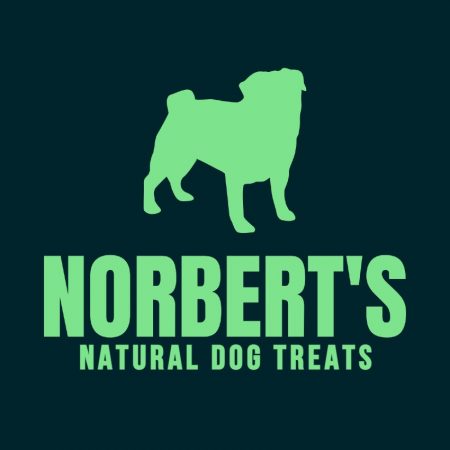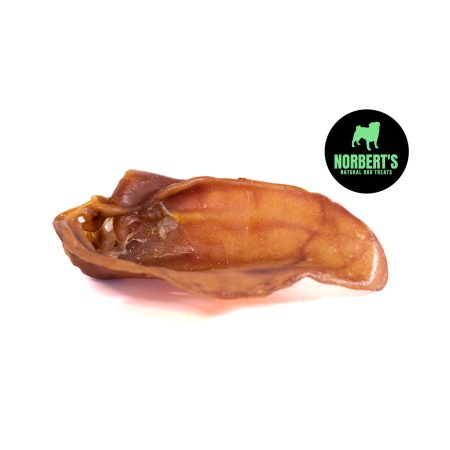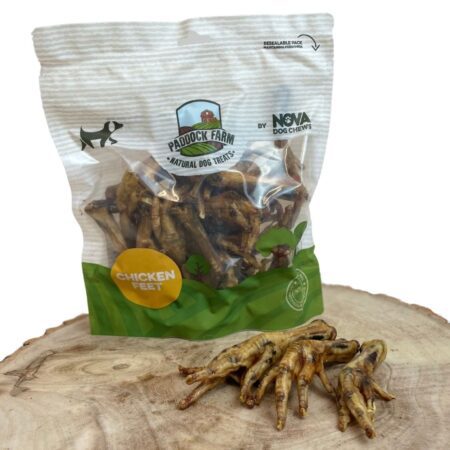Are Pig Ears Good for Dogs? A Balanced Guide
All you need to know about pig ears.

By: Georgina – Owner of Norbert’s Treats
Published: May 2025 | Last Updated: May 2025
Pig ears have earned their place on the treat shelf of many dog lovers, but some dog owners still aren’t sure if pig ears actually good for dogs.
Pigs ears have been around for decades and are one of the most popular natural dog treats, but as with any dog treat, it’s important to weigh the benefits against the potential drawbacks.
In this blog, we’ll look at the benefits of pigs ear for your dog and tell you what to be aware of when it comes to feeding your dog pig ears.

Table of Contents
What Are Pig Ears?
Pig ears are exactly what the name suggests – they’re the dried ears of pigs, usually either air-dried or baked to preserve them.
Unlike highly processed chews that contain numerous artificial additives and preservatives, pig ears tend to be a more natural, single-ingredient option.
Their soft yet chewy texture makes them appealing to dogs of all sizes, while their meaty smell catches a dog’s attention.
Available from most pet shops and increasingly popular among those who prefer natural feeding methods, pig ears for dogs have become a staple in many households.
The Benefits of Pig Ears for Dogs
Dental Health
Pigs ears can help with your dog’s dental health.
When dogs chew on them, it helps to remove plaque from their teeth and massage their gums.
This mimics the natural cleaning action that would occur if dogs were eating raw bones or wild prey in the wild.
Over time, this can reduce tartar build-up and support fresher breath, though it’s important to remember that no chew is a substitute for regular dental checks and brushing.
Mental Stimulation
Pig ears also offer valuable mental enrichment.
Dogs are natural chewers, and having a pig ear to focus on can provide them with a healthy outlet for their instincts. This can be especially useful for dogs that become anxious when left alone or tend to display destructive behaviours due to boredom.
A good chew can offer a welcome distraction and help reduce stress, promoting better overall wellbeing.
Source of protein and healthy fats
In terms of nutrition, pig ears are a source of protein and healthy fats. These are essential for maintaining your dog’s energy levels, supporting muscle development, and contributing to a glossy, healthy coat.
Some pig ears also contain small amounts of glucosamine and chondroitin, two naturally occurring compounds that are known to support joint health, especially in older or larger breeds prone to stiffness or arthritis.
Potential Risks and Considerations
Despite their benefits, pig ears are not without their drawbacks.
Calorific
One of the most pressing concerns is their high calorie and fat content. A single pig ear can contain over 200 calories, which is a significant proportion of the daily recommended intake for smaller dogs.
Regular consumption without adjusting overall food portions could lead to unwanted weight gain and, in some cases, obesity.
For this reason, pig ears should always be considered as part of a balanced diet.
Digestion
Some dogs also experience digestive upset after eating pig ears, especially if it’s their first time trying them. This can manifest as loose stools, vomiting, or general discomfort.
Because they are rich and quite fatty, pig ears might not agree with sensitive stomachs or breeds prone to gastrointestinal issues. Gradually introducing them and monitoring your dog afterwards can help avoid any nasty surprises.
Supervision
There’s also the issue of safety.
Pig ears can pose a choking hazard or cause internal blockages if swallowed in large chunks, particularly for dogs who are eager eaters and tend to gulp rather than chew thoroughly.
Supervision is essential when offering chews of any kind, but especially so with treats like pig ears that soften as they’re chewed.
Are Pig Ears Suitable for Every Dog?
Not every dog is a suitable candidate for pig ears.
Dogs with specific dietary requirements, such as those on low-fat diets or those with pancreatitis, should avoid them entirely. The rich fat content can trigger flare-ups in dogs with these conditions and pose unnecessary health risks.
Similarly, if your dog is overweight or prone to weight gain, pig ears might tip the balance of their calorie intake too far in the wrong direction.
Puppies and elderly dogs can also find pig ears difficult to manage. Puppies, especially those that are teething, may be tempted to swallow large pieces in their enthusiasm.
Older dogs, on the other hand, might struggle with the tough texture if they have weakened or missing teeth. In both cases, there are often better, softer chew alternatives that are safer and easier to digest.
As always, it’s worth having a chat with your treat supplier before introducing any new treat – especially if your dog has underlying health issues or you’re unsure how they might react.
How often can I give my dog pig ears?
Pig ears should be treated as an occasional snack rather than a daily treat. Because they’re high in fat and calories, offering one every week or two is usually sufficient for most dogs. The exact frequency will depend on your dog’s size, weight, and overall diet, so it’s always best to adjust according to their individual needs—and consult your vet if you’re unsure.
Are pig ears safe for puppies?
While pig ears are natural, they’re not always the best choice for young puppies. Puppies, especially those still teething, might chew too aggressively or swallow large chunks, which could lead to choking or digestive issues. If you do choose to offer a pig ear to a puppy, make sure it’s a smaller-sized one and supervise them closely at all times. For very young puppies, softer chews may be a safer alternative.
Are pig ears good for dogs with allergies?
Pig ears are a single-protein treat, which can be helpful for dogs on an elimination diet or those with allergies to common proteins like chicken or beef. However, not all dogs tolerate pork well. If your dog has known food sensitivities, it’s wise to speak with your vet before introducing pig ears as a new treat.
Do pig ears smell bad?
Most pig ears sold in the UK are processed in a way that reduces odour, but they can still have a strong, meaty smell, especially once they’ve been chewed on. Some owners find the smell off-putting, while dogs typically love it. If smell is a concern, look for low-odour pig ears from trusted UK suppliers.
So, Are Pig Ears Good for Dogs?
In short, yes—pig ears can be good for dogs, but only when offered responsibly and in moderation.
They’re a natural, tasty, and enriching treat that can provide dental benefits and keep your dog mentally stimulated. But they’re also high in fat, calorie-dense, and carry a few risks that need to be carefully managed.
The key is to choose high-quality pig ears from reputable UK suppliers, supervise your dog while they chew, and treat them as a once-in-a-while snack, not a staple.





